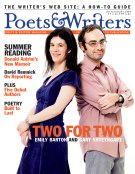A little less than two weeks into this year's National Poetry Month, the Poetry Foundation released Poetry in America, a report that analyzes American attitudes toward poetry. Conducted by the National Opinion Research Center at the University of Chicago and commissioned by the Poetry Foundation, the study is based on 1,023 interviews conducted over a four-month period beginning in June 2005—a random sample of American adults who read newspapers, magazines, and books for pleasure, and who read primarily in English. The most dramatic finding, according to a press release sent by the Poetry Foundation, was that "the vast majority (90 percent) of American readers highly value poetry." As news of this finding spread among writers and on blogs, the phrasing was sometimes shortened to "90 percent of Americans" rather than "American readers"—and suddenly, poetry seemed as popular as baseball and apple pie.
The findings indicate that positive experiences with poetry in school are integral to keeping people engaged with poetry in later life.
"Taken as a whole, the results of the study confirm the need to reinvigorate poetry as an art form and to expand its presence in American culture," says Poetry Foundation president John Barr. The Poetry Foundation, formerly the Modern Poetry Association, which received a $175 million bequest in 2002, appears to be in a position to do just that.
Poet Dana Gioia, chairman of the National Endowment for the Arts (NEA), puts the foundation's report in perspective: "[This] is not a study of the total U.S. population," he says. "It's easy to misrepresent the numbers.. Essentially, only 12 percent of the U.S. population reads poetry." That number comes from the NEA's 2004 report Reading at Risk, a study based on twenty years of data collection, which showed that only about 47 percent of Americans read any sort of literary work at all.
The two studies differ in several ways. For Reading at Risk, the NEA polled more than seventeen thousand people from the general adult population about their consumption of novels, short stories, plays, and poetry. The pool surveyed by the Poetry Foundation was made up solely of adults who read for pleasure. In addition, respondents in the foundation's study were given a definition of poetry, whereas those polled by the NEA were not. The Poetry Foundation's respondents were told a poem "uses rhythm and language in verses to create images in the mind of the reader"; that it might rhyme or it might not; and that greeting card poems, song lyrics, and Bible verses don't count. Depending on their responses, those interviewed were then classified into two groups: "users" and "nonusers" of poetry. Users were then further classified as "current" or "former."
According to the results of Poetry in America, more than half of current and former poetry users remember the title of a poem. Users are more active and social than nonusers, and they read more contemporary poetry than classics. Sixty-four percent of all respondents felt that, in general, people should read more poetry. The findings also indicate that positive experiences with poetry in school are integral to keeping people engaged with poetry in later life.
Along with launching a revamped Web site in January, the foundation has been working with the NEA to organize Poetry Out Loud, a program in which high school students take part in poetry recitation competitions. Tens of thousands of students have participated in the program to date—a sign of what Gioia calls "an enormous populist revival" of poetry through the spoken word.
Many poets aren't all that surprised by the Poetry Foundation's news that there is a relative enthusiasm for poetry on the page. "Maybe the more interesting question is, What are they reading, and what are they valuing it for?" says poet Daisy Fried, a 2006 Guggenheim fellow. In fact, the survey did ask respondents about specific works. Both current and former poetry users were asked to name their favorite poems, and while there are some classics at the top of the list—Edgar Allan Poe's "The Raven" is number one, and Robert Frost's "Stopping by Woods on a Snowy Evening," number four—number two is Mary Stevenson's "Footprints," an inspirational work, and number eleven, Rudyard Kipling's "If." Also in the mix are titles such as "Humpty Dumpty" and "The Grinch That Stole Christmas [sic]."
The wide range of works mentioned by respondents in Poetry in America has sparked some debate in the literary community about real or perceived divisions between serious poetry and casual or lightweight verse. "I suspect the casual reader isn't necessarily interested in the things in poetry that poets are interested in," says Fried. In fact, some poets even take comfort in that divide. "This is one of the things that make this little unspoken-word poetry world so compelling to those of us who are stuck inside it: It is truly arcane.. It's a secret-magic-invisible world," says Rebecca Wolff, a poet and the publisher of Fence magazine and Fence Books.
Others endorse the populist approach promoted by the Poetry Foundation, whose mission is to place the best poetry before the largest possible audience. "I think the depth of engagement with poetry is launched from a very broad swath of the [public's] being interested in it, and that means having a huge layer of people interested in somewhat lightweight verse," says Tree Swenson, executive director of the Academy of American Poets. In other words, the larger the number of poetry users—even if those users consider Dr. Seuss a poetic master—the greater the number of people who might one day wander into the poetry section at Barnes & Noble, pick up a book by Emily Dickinson or Frank O'Hara or Wallace Stevens, and be mesmerized by what they read.
And that, most everyone can agree, would be something to celebrate.
Sarah Davis is a poet and fiction writer who lives in Brooklyn.








